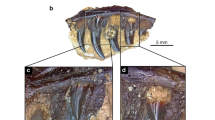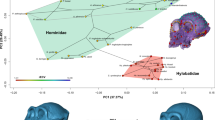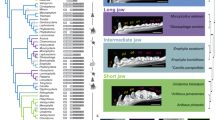Abstract
Early terrestrial vertebrates (amniotes) provide a classic example of diversification following adaptive zone invasion. The initial terrestrialization of vertebrates was closely followed by dietary diversification, as evidenced by a proliferation of craniomandibular and dental adaptations. However, morphological evolution of early amniotes has received limited study, in analyses with restricted taxonomic scope, leaving substantial questions about the dynamics of this important terrestrial radiation. We use novel analyses of discrete characters to quantify variation in evolutionary rates and constraints during diversification of the amniote feeding apparatus. We find evidence for an early burst, comprising high rates of anatomical change that decelerated through time, giving way to a background of saturated morphological evolution. Subsequent expansions of phenotypic diversity were not associated with increased evolutionary rates. Instead, variation in the mode of evolution became important, with groups representing independent origins of herbivory evolving distinctive, group-specific morphologies and thereby exploring novel character-state spaces. Our findings indicate the importance of plant–animal interactions in structuring the earliest radiation of amniotes and demonstrate the importance of variation in modes of phenotypic divergence during a major evolutionary radiation.
This is a preview of subscription content, access via your institution
Access options
Access Nature and 54 other Nature Portfolio journals
Get Nature+, our best-value online-access subscription
$29.99 / 30 days
cancel any time
Subscribe to this journal
Receive 12 digital issues and online access to articles
$119.00 per year
only $9.92 per issue
Buy this article
- Purchase on Springer Link
- Instant access to full article PDF
Prices may be subject to local taxes which are calculated during checkout



Similar content being viewed by others
Code availability
The analysis code is available in Supplementary Data 7.
References
Frazzetta, T. H. Adaptive problems and possibilities in the temporal fenestration of tetrapod skulls. J. Morph. 125, 145–158 (1968).
Janis, C. M. & Keller, J. C. Modes of ventilation in early tetrapods: costal aspiration as a key feature of amniotes. Acta Palaeontol. Pol. 46, 137–170 (2001).
Olson, E. C. Community evolution and the origin of mammals. Ecology 47, 291–302 (1966).
DiMichele, W. A. & Aronson, R. B. The Pennsylvanian–Permian vegetational transition: a terrestrial analogue to the onshore–offshore hypothesis. Evolution 46, 807–824 (1992).
Sues, H.-D. & Reisz, R. R. Origins and early evolution of herbivory in tetrapods. Trends Ecol. Evol. 13, 141–145 (1998).
Olson, E. C. The family Diadectidae and its bearing on the classification of reptiles. Fieldiana Geol. 11, 1–53 (1947).
Hotton, N., Olson, E. C. & Beerbower, R. in Amniote Origins (eds Sumida, S. S. & Martin K. L. M.) 207–264 (San Diego Academic Press, 1996).
Dodick, J. T. & Modesto, S. The cranial anatomy of the captorhinid reptile Labidosaurikos meachami from the lower Permian of Oklahoma. Palaeontology 38, 687–711 (1995).
Modesto, S. P. The skull of the herbivorous synapsid Edaphosaurus boanerges from the lower Permian of Texas. Palaeontology 38, 213–239 (1995).
King, G. M., Oelofsen, B. W. & Rubidge, B. S. The evolution of the dicyndont feeding system. Zool. J. Linn. Soc. 96, 185–211 (1988).
Simpson, G. G. Tempo and Mode in Evolution (Columbia Univ. Press, 1944).
Simpson, G. G. The Major Features of Evolution (Columbia Univ. Press, 1953).
Schluter, D. The Ecology of Adaptive Radiation (Oxford Univ. Press, 2000).
Givnish, T. J. Ecology of plant speciation. Taxon 59, 1326–1366 (2010).
Givnish, T. J. Adaptive radiation versus ‘radiation’ and ‘explosive diversification’: why conceptual distinctions are fundamental to understanding evolution. New Phytol. 207, 297–303 (2015).
Valentine, J. W. Determinants of diversity in higher taxonomic categories. Paleobiology 6, 444–450 (1980).
Gould, S. J. The disparity of the Burgess Shale arthropod fauna and the limits of cladistic analysis: why we must strive to quantify morphospace. Paleobiology 17, 411–423 (1991).
Briggs, D. E. G., Fortey, R. A. & Wills, M. A. Morphological disparity in the Cambrian. Science 256, 1670–1673 (1992).
Ingram, T. & Kai, Y. The geography of morphological convergence in the radiations of Pacific Sebastes rockfishes. Am. Nat. 184, 115–131 (2014).
Harmon, L. J. et al. Early bursts of body size and shape evolution are rare in comparative data. Evolution 64, 2385–2396 (2010).
Puttick, M. N. Mixed evidence for early bursts of morphological evolution in extant clades. J. Evol. Biol. 31, 502–515 (2018).
Foote, M. Morphological disparity in Ordovician–Devonian crinoids and the early saturation of morphological space. Paleobiology 20, 320–344 (1994).
Grant, V. Plant Speciation (Columbia Univ. Press, 1981).
Blomberg, S. P., Garland, T. & Ives, A. R. Testing for phylogenetic signal in comparative data: Behavioural traits are more labile. Evolution 57, 717–745 (2003).
Mahler, D. L., Revell, L. J., Glor, R. E. & Losos, J. B. Ecological opportunity and the rate of morphological evolution in the diversification of Greater Antillean anoles. Evolution 64, 2731–2745 (2010).
Harmon, L. J., Schulte, J. A., Larson, A. & Losos, J. B. Tempo and mode of evolutionary radiation in iguanian lizards. Science 301, 961–964 (2003).
Sidlaukas, B. Continuous and arrested morphological diversification in sister clades of characiform fishes: a phylomorphospace approach. Evolution 62, 3135–3156 (2008).
Valentine, J. W. & Erwin, D. H. in Development as an Evolutionary Process (eds Raff, R. A. & Raff, E. C.) 71–107 (Liss, 1987).
Erwin, D. H., Valentine, J. W. & Jablonski, D. The origin of animal body plans. Am. Sci. 85, 126–137 (1997).
Stanley, S. M. Paleozoic mass extinctions: shared patterns suggest global cooling as a common cause. Am. J. Sci. 288, 334–352 (1988).
Bengston, S. in Early Life on Earth (ed. Bengston, S.) 412–425 (Columbia Univ. Press, 1994).
Anderson, P. S. L., Friedman, M. & Ruta, M. Late to the table: diversification of tetrapod mandibular biomechanics lagged behind the evolution of terrestriality. Integr. Comp. Biol. 53, 197–208 (2013).
Olson, E. C. Jaw mechanisms: rhipidisteans, amphibians and reptiles. Am. Zool. 1, 205–215 (1961).
Carroll, R. L. Problems of the origin of reptiles. Biol. Rev. 44, 393–432 (1968).
Pearson, M. R., Benson, R. B. J., Upchurch, P., Fröbisch, J. & Kammerer, C. F. Reconstructing the diversity of early terrestrial herbivorous tetrapods. Palaeogeogr. Palaeoclim. Palaeoecol. 372, 42–49 (2013).
Brocklehurst, N., Ruta, M., Müller, J. & Fröbisch, J. Elevated extinction rates as a trigger for diversification rate shifts: early amniotes as a case study. Sci. Rep. 5, 17104 (2015).
Brocklehurst, N., Kammerer, C. F. & Benson, R. B. J. The origin of tetrapod herbivory: effects on local plant diversity. Proc. R. Soc. B 287, 20200124 (2020).
Neige, P., Dera, G. & Dommergues, J. L. Adaptive radiation in the fossil record: a case study among Jurassic ammonoids. Palaeontology 56, 1247–1261 (2013).
Simões, M. et al. The evolving theory of evolutionary radiations. Trends Ecol. Evol. 31, 27–34 (2016).
Ruta, M., Angielczyk, K., Fröbisch, J. & Benton, M. J. Decoupling of morphological disparity and taxic diversity during the adaptive radiation of anomodont therapsids. Proc. R. Soc. B 280, 20131071 (2013).
Brocklehurst, N. Rates of morphological evolution in Captorhinidae: an adaptive radiation of Permian herbivores. PeerJ 5, e3200 (2017).
Grunert, H. R., Brocklehurst, N. & Fröbisch, J. Diversity and disparity of Therocephalia: macroevolutionary patterns through two mass extinctions. Sci. Rep. 9, 5063 (2019).
MacDougall, M. J., Brocklehurst, N. & Fröbisch, J. Species richness and diversity of parareptiles across the end-Permian mass extinction. Proc. R. Soc. B 286, 20182572 (2018).
Brocklehurst, N. Morphological evolution in therocephalians breaks the hypercarnivore ratchet. Proc. R. Soc. B 286, 20190590 (2019).
van Valkenberg, B. in Carnivore Behaviour, Ecology and Evolution (ed. Gittleman, J.) 410–436 (Springer, 1989).
Jernvall, J., Hunter, J. P. & Fortelius, M. Molar tooth diversity, disparity and ecology in Cenozoic ungulate radiations. Science 274, 1489–1492 (1996).
Schwenk, K. Feeding: Form, Function and Evolution in Terrestrial Vertebrates (Academic Press, 2000).
Müller, J. & Reisz, R. R. The phylogeny of early eureptiles: comparing parsimony and Bayesian approaches in the investigation of a basal fossil clade. Syst. Biol. 55, 503–511 (2006).
Carroll R. L. & Gaskill P. The Order Microsauria (American Philosophical Society, 1978).
Brocklehurst, N., Reisz, R. R., Fernandez, V. & Fröbisch, J. A re-description of ‘Mycterosaurus’ smithae, an early Permian eothyridid, and its impact on the phylogeny of pelycosaurian-grade synapsids. PLoS ONE 11, e60156810 (2016).
Ford, D. P. & Benson, R. B. J. The phylogeny of early amniotes and the affinities of Parareptilia and Varanopidae. Nat. Ecol. Evol. 4, 57–65 (2020).
Ruta, M., Wagner, P. J. & Coates, M. I. Evolutionary patterns in early tetrapods. I. Rapid initial diversification followed by decrease in rates of character change. Proc. R. Soc. B 273, 2113–2118 (2006).
Sahney, S. & Benton, M. J. Recovery from the most profound mass extinction of all time. Proc. R. Soc. B 275, 759–765 (2008).
Brocklehurst, N., Day, M. O., Rubidge, B. S. & Fröbisch, J. Olson’s extinction and the latitudinal biodiversity gradient of tetrapods in the Permian. Proc. R. Soc. B 284, 20170231 (2017).
Brocklehurst, N. An examination of the impact of Olson’s extinction on tetrapods from Texas. PeerJ 6, e4767 (2018).
Brocklehurst, N., Kammerer, C. F. & Fröbisch, J. The early evolution of synapsids and the influence of sampling on their fossil record. Paleobiology 39, 470–490 (2013).
Fröbisch, J. Composition and similarity of global anomodont-bearing tetrapod faunas. Earth Sci. Rev. 95, 119–157 (2009).
MacDougall, M. J., Brocklehurst, N. & Fröbisch, J. Species richness and disparity of parareptiles across the end-Permian mass extinction. Proc. R. Soc. B 286, 20182572 (2018).
Brocklehurst, N., Panciroli, E., Benevento, G. L. & Benson, R. B. J. Mammaliaform extinctions as a driver of the morphological radiation of Cenozoic mammals. Curr. Biol. https://doi.org/10.1016/j.cub.2021.04.044 (2021).
Wagner, P. J. Exhaustion of morphologic character states among fossil taxa. Evolution 54, 365–386 (2000).
Nee, S., Mooers, A. O. & Harvey, P. H. Tempo and mode of evolution revealed from molecular phylogenies. Proc. Natl Acad. Sci. USA 89, 8322–8326 (1992).
Seehausen, O. African cichlid fish: a model system in adaptive radiation research. Proc. Natl Acad. Sci. USA 73, 1987–1998 (2006).
Phillimore, A. B. & Price, T. D. Density-dependent cladogenesis in birds. PLoS Biol. 6, e71 (2008).
McPeek, M. A. The ecological dynamics of clade diversification and community assembly. Am. Nat. 172, E270–E284 (2008).
Rabosky, D. L. & Lovette, I. J. Explosive evolutionary radiations: decreasing speciation or increasing extinction through time? Evolution 62, 1866–1875 (2009).
O’Donovan, C., Meade, A. & Venditti, C. Dinosaurs reveal the geographic signal of an evolutionary radiation. Nat. Ecol. Evol. 2, 452–458 (2018).
Foote, M. The evolution of morphological diversity. Annu. Rev. Ecol. Syst. 28, 129–152 (1997).
Hughes, M., Gerber, S. & Wills, M. A. Clades reach highest morphological disparity early in their evolution. Proc. Natl Acad. Sci. USA 110, 13875–13879 (2013).
Sidlaukas, B. Testing for unequal rates of morphological diversification in the absence of a detailed phylogeny: a case study from characiform fishes. Evolution 61, 299–316 (2007).
Benson, R. B. J., Hunt, G., Carrano, M. T. & Campione, N. Cope’s rule and the adaptive landscape of dinosaur body size. Palaeontology 61, 13–48 (2018).
Hill, J. J., Puttick, M. N., Stubbs, T. L., Rayfield, E. J. & Donoghue, P. C. Evolution of jaw disparity in fishes. Palaeontology 61, 847–854 (2018).
Simões, T. R., Vernygora, O., Caldwell, M. W. & Pierce, S. E. Megaevolutionary dynamics and the timing of evolutionary innovation in reptiles. Nat. Commun. 11, 3322 (2020).
Oyston, J. W., Hughes, M., Gerber, S. & Wills, M. A. Why should we investigate the morphological disparity of plant clades? Ann. Bot. 117, 859–879 (2016).
Lofgren, A. S., Plotnick, R. E. & Wagner, P. J. Morphological diversity of Carboniferous arthropods and insights on disparity patterns through the Phanerozoic. Paleobiology 29, 349–368 (2003).
Condamine, F. L., Clapham, M. E. & Kergoat, G. J. Global patterns of insect diversification: towards a reconciliation of fossil and molecular evidence. Sci. Rep. 6, 19208 (2016).
Labandeira, C. C. & Sepkoski, J. J. Insect diversity in the fossil record. Science 261, 310–315 (1993).
Lee, M. S. Y., Soubrier, J. & Edgecombe, G. D. Rates of phenotypic and genomic evolution during the Cambrian Explosion. Curr. Biol. 23, 1889–1895 (2013).
Halliday, T. J. D., Upchurch, P. & Goswami, A. Eutherians experienced elevated evolutionary rates in the immediate aftermath of the Cretaceous–Palaeogene mass extinction. Proc. R. Soc. B 283, 20153026 (2016).
Schaeffer, B. Rates of evolution in the coelacanth and dipnoan fishes. Evolution 6, 101–111 (1952).
Lloyd, G. T., Wang, S. C. & Brusatte, S. L. Identifying heterogeneity in rates of morphological evolution: discrete character change in the evolution of lungfish (Sarcopterygii; Dipnoi). Evolution 66, 330–348 (2012).
Wright, D. F. Phenotypic innovation and adaptive constraints in the evolutionary radiation of Palaeozoic crinoids. Sci. Rep. 7, 13745 (2017).
Wagner, P. J. Early bursts of disparity and the reorganization of character integration. Proc. R. Soc. B 285, 20181604 (2018).
Slater, G. J., Harmon, L. J. & Alfaro, M. E. Integrating fossils with molecular phylogenies improves inference of trait evolution. Evolution 66, 3931–3944 (2012).
Brocklehurst, N., Dunne, E. M., Cashmore, D. D. & Fröbisch, J. Physical and environmental drivers of Paleozoic tetrapod dispersal across Pangaea. Nat. Commun. 9, 5216 (2018).
Pardo, J. D., Szostakiwskyj, M., Ahlberd, P. E. & Anderson, J. S. Hidden morphological diversity among early tetrapods. Nature 546, 642–645 (2017).
Baum, B. Combining trees as a way of combining data sets for phylogenetic inference, and the desirability of combining gene trees. Taxon 41, 3–10 (1992).
Ragan, M. Phylogenetic inference based on matrix representation of trees. Mol. Phylogenet. Evol. 1, 53–58 (1992).
Salamin, N., Hodkinson, T. R. & Savolainen, V. Building supertrees: an empirical assessment using the grass family (Poaceae). Syst. Biol. 51, 134–150 (2002).
Goloboff, P. A., Farris, J. S. & Nixon, K. C. TNT, a free program for phylogenetic analysis. Cladistics 24, 774–786 (2008).
Heath, T. A., Huelsenbeck, J. P. & Stadler, T. The fossilized birth–death process for coherent calibration of divergence-time estimates. Proc. Natl Acad. Sci. USA 111, E2957–E2966 (2014).
Ronquist, F. & Huelsenbeck, J. P. MrBayes 3: Bayesian phylogenetic inference under mixed models. Bioinformatics 19, 1572–1574 (2003).
Pyron, R. A. A likelihood method for assessing molecular divergence-time estimates and the placement of fossil calibrations. Syst. Biol. 59, 185–194 (2010).
Lloyd, G. T. Estimating morphological diversity and tempo with discrete character–taxon matrices: implementation, challenges, progress and future directions. Biol. J. Linn. Soc. 118, 131–151 (2016).
Guillerme, T. & Cooper, N. Time for a rethink: time sub-sampling methods in disparity-through-time analyses. Palaeontology 61, 481–493 (2018).
Bollback, J. P. SIMMAP: stochastic character mapping of discrete traits on phylogenies. BMC Bioinformatics 7, 88 (2006).
Revell, L. J. phytools: an R package for phylogenetic comparative biology (and other things). Methods Ecol. Evol. 3, 217–223 (2012).
Jombart, T., Balloux, F. & Dray, S. Adephylo: new tools for investigating the phylogenetic signal in biological traits. Bioinformatics 26, 1907–1909 (2010).
Acknowledgements
N.B. thanks D. Button, M. Ezcurra, D. Ford, C. Kammerer, J. Ponstein and X.-C. Wu for helpful discussions and assistance with character scores; A. S. Murray and M. Day (Natural History Museum London), D. Schwarz (Museum für Naturkunde, Berlin), N.-E. Jalil (Muséum National d’Histoire Naturelle, Paris), S. Jirah and B. Zipfel (Evolutionary Studies Institute, Johannesburg), C. Mehling and M. Norrell (American Museum of Natural History, New York), J. Cundiff (Museum of Comparative Zoology, Harvard) and W. Simpson (Field Museum of Natural History, Chicago) for access to specimens and assistance during visits to collections. N.B.’s research was funded by Deutsche Forschungsgemeinschaft grant number BR 5724/1-1, Palaeontological Association Research grant number PA-RG201901 and a Collections Study Grant from the American Museum of Natural History. Parts of this work were funded by the European Union’s Horizon 2020 research and innovation program 2014–2018 under grant agreement 677774 (European Research Council (ERC) Starting Grant: TEMPO) to R.J.B.
Author information
Authors and Affiliations
Contributions
N.B. conceptualized the project, and collected and analysed the data. N.B. and R.J.B. developed the methodology and wrote the manuscript.
Corresponding author
Ethics declarations
Competing interests
The authors declare no competing interests.
Additional information
Peer review information Nature Ecology & Evolution thanks Peter Wagner and the other, anonymous, reviewer(s) for their contribution to the peer review of this work. Peer reviewer reports are available.
Publisher’s note Springer Nature remains neutral with regard to jurisdictional claims in published maps and institutional affiliations.
Supplementary information
Supplementary Information
Supplementary Datasets 1 and 2, Figs. 1 and 2, Table 1, and Data 1–7.
Supplementary Table 1
By-interval t tests, comparing the disparity values obtained at each time slice to those of the preceding slice, and identifying intervals where significant shifts occurred. Intervals with significant shifts (P < 0.05) are highlighted in yellow.
Supplementary Data 1
Character taxon matrix and MrBayes commands for time calibration of the tree, constraining the topology to that of the main text supertree.
Supplementary Data 2
Character taxon matrix and MrBayes commands for time calibration of the tree, constraining the topology to that of Ford and Benson51.
Supplementary Data 3
Maximum clade credibility time-calibrated tree of the main text supertree.
Supplementary Data 4
Maximum clade credibility time-calibrated tree of the supertree constrained to the Ford and Benson topology.
Supplementary Data 5
Maximum clade credibility tree of the main text supertree, with branch lengths representing morphological change instead of time.
Supplementary Data 6
First and last appearances and diet of taxa.
Supplementary Data 7
Analysis script.
Rights and permissions
About this article
Cite this article
Brocklehurst, N., Benson, R.J. Multiple paths to morphological diversification during the origin of amniotes. Nat Ecol Evol 5, 1243–1249 (2021). https://doi.org/10.1038/s41559-021-01516-x
Received:
Accepted:
Published:
Issue Date:
DOI: https://doi.org/10.1038/s41559-021-01516-x
This article is cited by
-
Predatory synapsid ecomorphology signals growing dynamism of late Palaeozoic terrestrial ecosystems
Communications Biology (2024)
-
A new Carboniferous edaphosaurid and the origin of herbivory in mammal forerunners
Scientific Reports (2023)
-
Derived faunivores are the forerunners of major synapsid radiations
Nature Ecology & Evolution (2023)
-
Divergent vertebral formulae shape the evolution of axial complexity in mammals
Nature Ecology & Evolution (2023)



